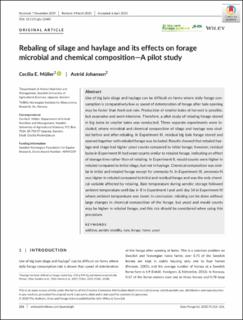| dc.description.abstract | Use of big bale silage and haylage can be difficult on farms where daily forage consumption is comparatively low as speed of deterioration of forage after bale opening may be faster than feed‐out rate. Production of smaller bales at harvest is possible, but expensive and work‐intensive. Therefore, a pilot study of rebaling forage stored in big bales to smaller bales was conducted. Three separate experiments were included, where microbial and chemical composition of silage and haylage was studied before and after rebaling. In Experiment III, residual big bale forage stored and opened together with rebaled forage was included. Results showed that rebaled haylage and silage had higher yeast counts compared to initial forage; however, residual bales in Experiment III had yeast counts similar to rebaled forage, indicating an effect of storage time rather than of rebaling. In Experiment II, mould counts were higher in rebaled compared to initial silage, but not in haylage. Chemical composition was similar in initial and rebaled forage except for ammonia‐N. In Experiment III, ammonia‐N was higher in rebaled compared to initial and residual forage and was the only chemical variable affected by rebaling. Bale temperature during aerobic storage followed ambient temperature until day 6–8 in Experiment I and until day 14 in Experiment III where ambient temperature was lower. In conclusion, rebaling can be done without large changes in chemical composition of the forage, but yeast and mould counts may be higher in rebaled forage, and this risk should be considered when using this procedure. | en_US |

